heater JAGUAR XJ6 1994 2.G Workshop Manual
[x] Cancel search | Manufacturer: JAGUAR, Model Year: 1994, Model line: XJ6, Model: JAGUAR XJ6 1994 2.GPages: 521, PDF Size: 17.35 MB
Page 9 of 521
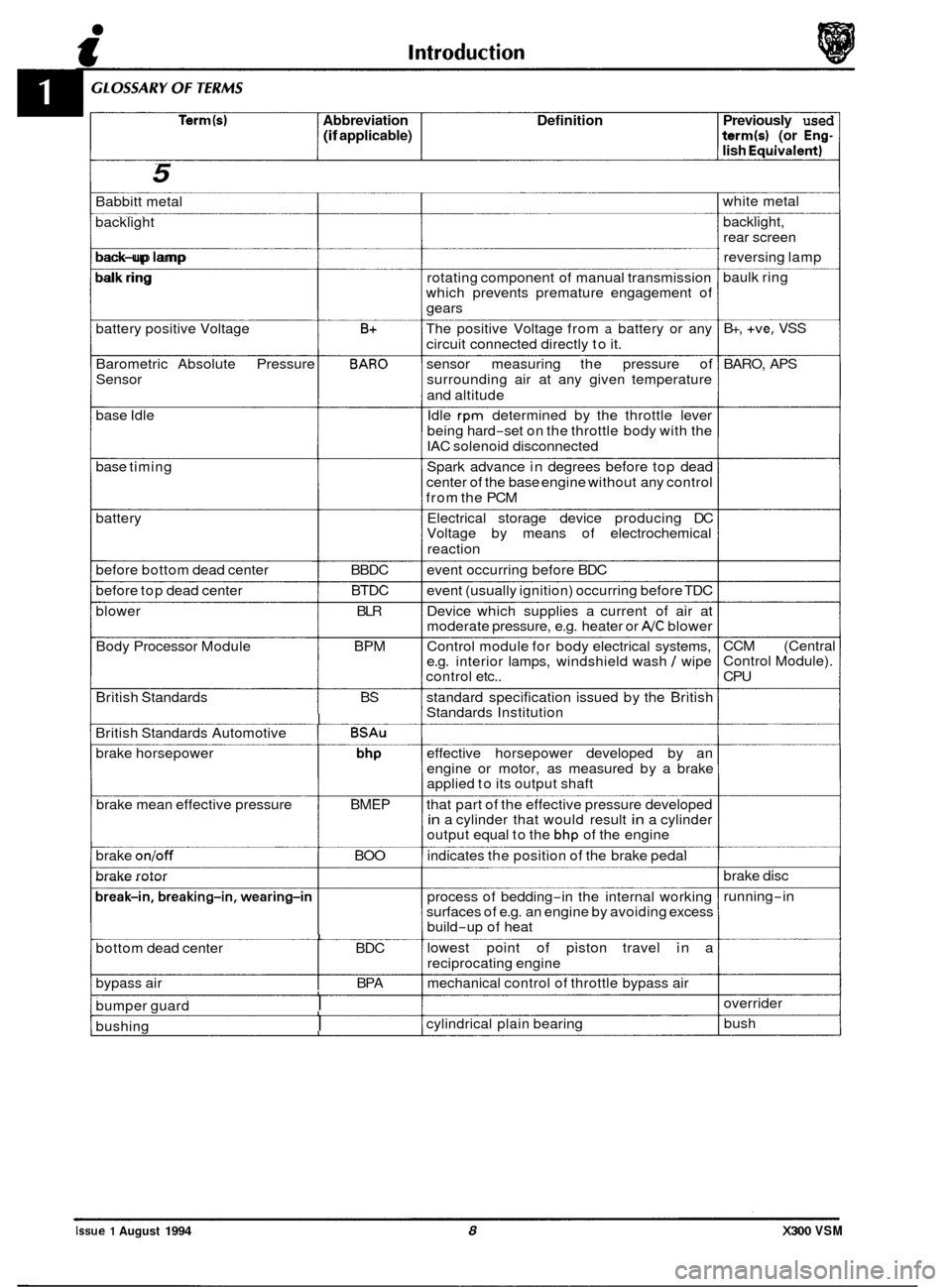
Terrn(s1 Abbreviation Definition Previously used (if applicable) term(s) (or Eng- lish Eauivalentl
5
Babbitt metal
backlight
back
-up lamp
balk ring
t
battery positive Voltage B+
Barometric Absolute Pressure BARO
Sensor
base Idle
base timing
battery
before bottom dead center BBDC
before top dead center BTDC
blower BLR
Body Processor Module BPM
British Standards BS
I British Standards Automotive BSAu
brake horsepower
brake mean effective pressure BMEP
brake
ontoff BOO
brake rotor
I bottom dead center BDC
bypass air BPA
bumper guard
I
bushing I
rotating component of manual transmission
which prevents premature engagement of
gears
The positive Voltage from
a battery or any
circuit connected directly to it.
sensor measuring the pressure of
surrounding air at any given temperature
and altitude
Idle
rpm determined by the throttle lever
being hard
-set on the throttle body with the
IAC solenoid disconnected
Spark advance in degrees before top dead
center of the base engine without any control
from the PCM
Electrical storage device producing DC
Voltage by means of electrochemical
reaction
event occurring before BDC
event (usually ignition) occurring before TDC
Device which supplies a current of air at
moderate pressure, e.g. heater or
AJC blower
Control module for body electrical systems,
e.g. interior lamps, windshield wash wipe
control etc..
standard specification issued by the British
Standards Institution
effective horsepower developed by an
engine or motor, as measured by a brake
applied to its output shaft
that part of the effective pressure developed
in a cylinder that would result in a cylinder
output equal to the bhp of the engine
indicates the position of the brake pedal
process of bedding
-in the internal working
surfaces of e.g. an engine by avoiding excess
build
-up of heat
lowest point of piston travel in a
reciprocating engine
mechanical control of throttle bypass air
cylindrical plain bearing white
metal
backlight,
rear screen reversing lamp
baulk ring
B+,
+ve, VSS
BARO, APS
CCM (Central
Control Module).
CPU
brake disc
running
-in
overrider bush
Issue 1 August 1994 8 X300 VSM
Page 12 of 521
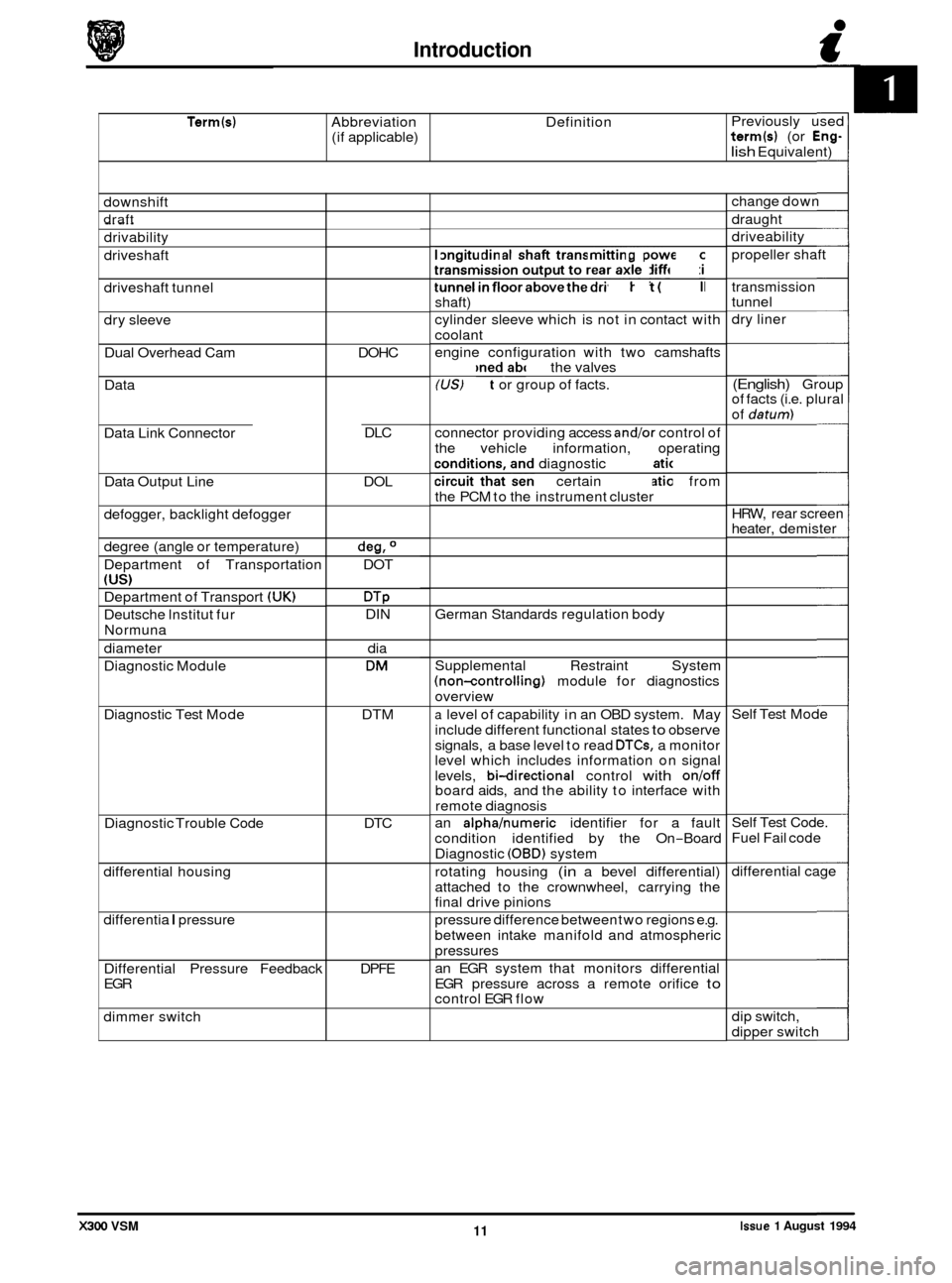
Introduction
Term(s) Abbreviation Definition
(if applicable) Previously
used term(s) (or Eng-
lish Equivalent)
downshift
draft _.
drivability
driveshaft
driveshaft tunnel
dry sleeve
Dual Overhead Cam
Data
Data Link Connector
Data Output Line
defogger, backlight defogger
degree (angle or temperature)
Department of Transportation
(US)
Department of Transport (UK)
Deutsche lnstitut fur
Normuna
diameter
Diagnostic Module
Diagnostic Test Mode
Diagnostic Trouble Code
differential housing
differentia
I pressure
Differential Pressure Feedback
EGR
dimmer switch DOHC
DLC
DOL
deg, O
DOT
DTP DIN dia
DM
DTM
DTC
DPFE longitudinal
shaft transmitting power from
transmission output to rear axle differential
tunnel
in floor above the driveshaft (propeller
shaft)
cylinder sleeve which is not in contact with
coolant
engine configuration with two camshafts
positioned above the valves
(US) Fact or group of facts.
connector providing access
andlor control of
the vehicle information, operating
conditions, and diagnostic information
circuit that sends certain information from
the PCM to the instrument cluster
German Standards regulation body
Supplemental Restraint System
(non-controlling) module for diagnostics
overview
a level of capability in an OBD system. May
include different functional states
to observe
signals, a base level to read
DTCs, a monitor
level which includes information on signal
levels,
bi-directional control with onloff board aids, and the ability to interface with
remote diagnosis
an
alphahumeric identifier for a fault
condition identified by the On
-Board
Diagnostic
(OBD) system
rotating housing
(in a bevel differential)
attached to the crownwheel, carrying the
final drive pinions
pressure difference between two regions e.g.
between intake manifold and atmospheric
pressures
an EGR system that monitors differential
EGR pressure across a remote orifice
to control EGR flow change
down
draught
driveability
propeller shaft
transmission
tunnel
dry liner
(English) Group
of facts (i.e. plural
of
datum)
HRW, rear screen
heater, demister
Self Test Mode
Self Test Code.
Fuel Fail code
differential cage
dip switch,
dipper switch
Issue 1 August 1994 11 X300 VSM
Page 40 of 521
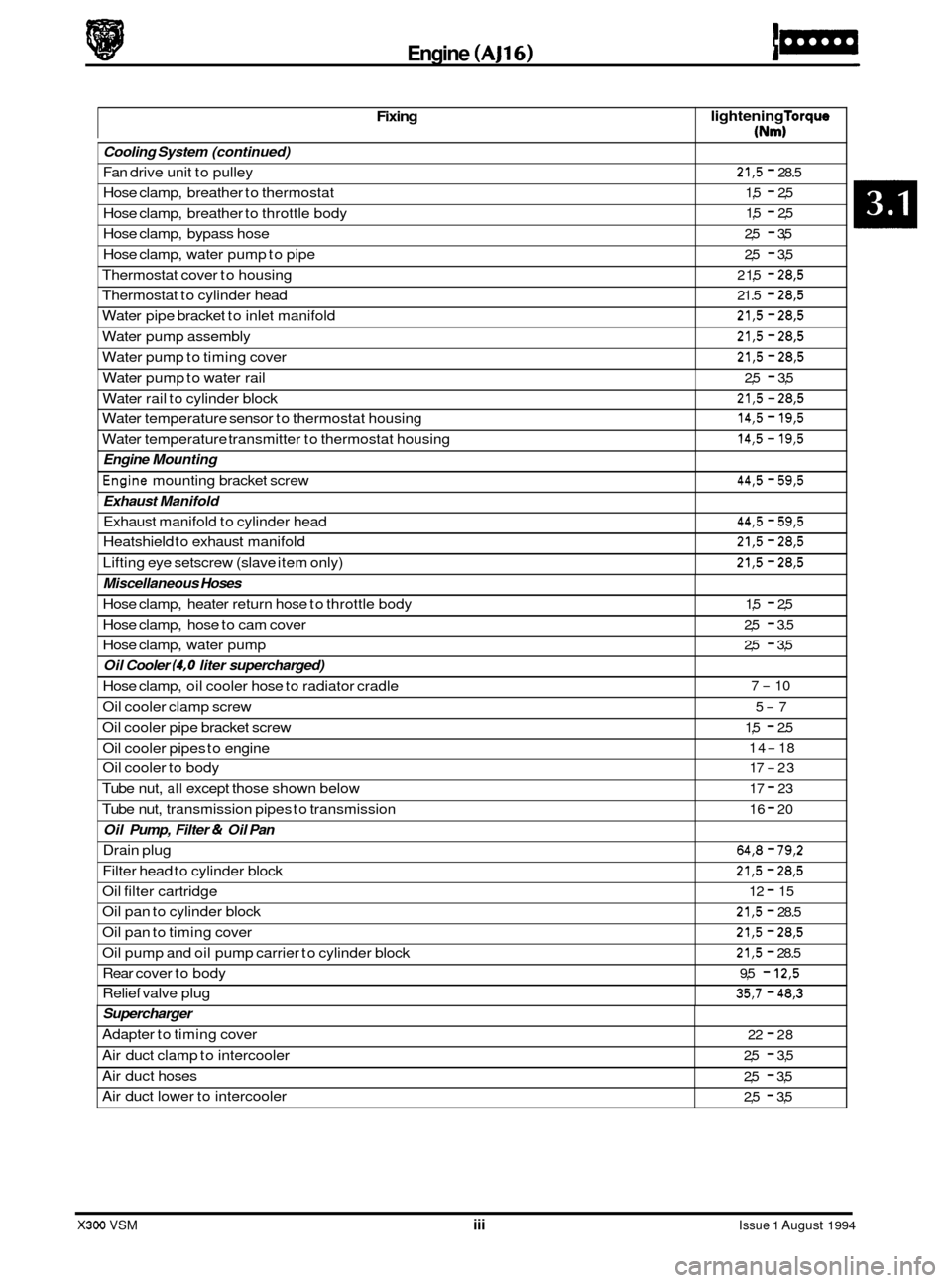
Engine (AJ16) 1-
Fixing lightening Torque
(Nm)
Cooling System
(continued)
Fan drive unit to pulley
Hose clamp, breather to thermostat
Hose clamp, breather to throttle body
Hose clamp, bypass hose
Hose clamp, water pump to pipe
Thermostat cover to housing
Thermostat to cylinder head
Water pipe bracket to inlet manifold 21,5 - 28.5
1,5
- 2,5
1,5
- 2,5
2,5
- 3,5
2,5
- 3,5
2 1,5
- 28,5
21.5 - 28,5
21,5 - 28,5
Water pump assembly
Water pump to timing cover 21,5 - 28,5
21,5 - 28,5
Water pump to water rail 2,5 - 3,5
Water rail to cylinder block
X300 VSM iii Issue 1 August 1994
21,5 - 28,5
@
Water temperature sensor to thermostat housing
Water temperature transmitter to thermostat housing 14,5 - 19,5
14,5 - 19,5
44,5 - 59,5
Engine Mounting
*Engine mounting bracket screw
' Exhaust Manifold
Exhaust manifold to cylinder head
Heatshield to exhaust manifold
Lifting eye setscrew (slave item only) 44,5 - 59,5
21,5 - 28,5
21,5 - 28,5
Miscellaneous Hoses
Hose clamp, heater return hose to throttle body
Hose clamp, hose to cam cover
Hose clamp, water pump
Oil Cooler (4,O liter supercharged)
Hose clamp, oil cooler hose to radiator cradle
Oil cooler clamp screw
5-7
Oil cooler pipe bracket screw
Oil cooler pipes to engine
Oil cooler to body
Tube nut,
all except those shown below
Tube nut, transmission pipes to transmission
1,5 - 2,5
2,5
- 3.5
2,5
- 3,5
7
- 10
1,5
- 2.5
14
- 18
17
-23
17
- 23
16
- 20
Oil Pump, Filter & Oil Pan
Drain plug 64,8 - 79,2
Filter head to cylinder block 21,5 - 28,5
Oil filter cartridge 12 - 15
Oil pan to cylinder block 21,5 - 28.5
Oil pan to timing cover 21,5 - 28,5
Oil pump and oil pump carrier to cylinder block 21,5 - 28.5
Rear cover to body 9,5 - 12,5
Relief valve plug 35,7 - 48,3
Supercharger
Adapter to timing cover
Air duct clamp to intercooler
Air duct hoses
Air duct lower to intercooler 22 - 28
2,5
- 3,5
2,5
- 3,5
2,5
- 3,5
Page 56 of 521
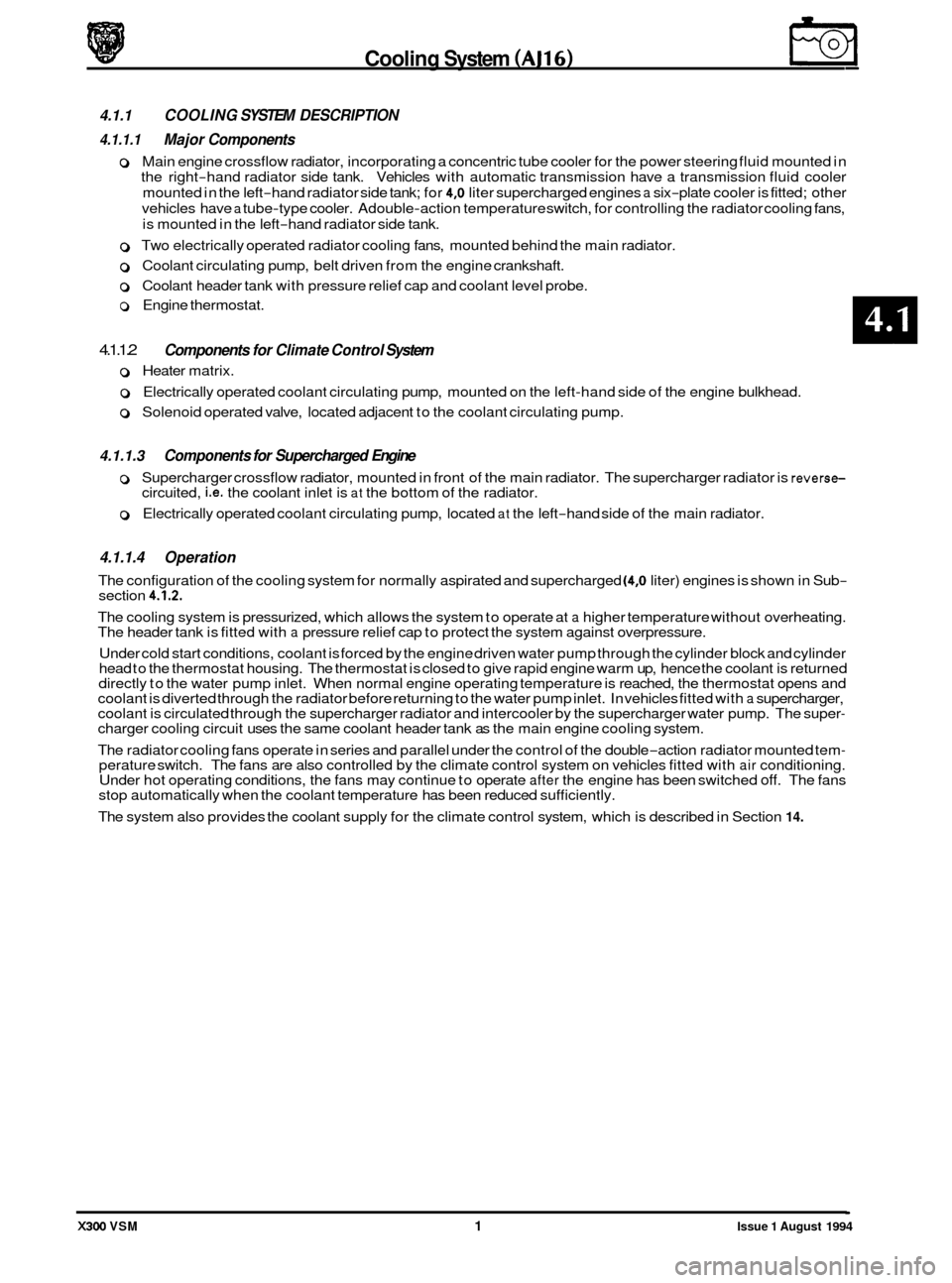
Cooling System (AJl6) m
4.1.1 COOLING SYSTEM DESCRIPTION
4.1.1.1 Major Components
o Main engine crossflow radiator, incorporating a concentric tube cooler for the power steering fluid mounted in
the right
-hand radiator side tank. Vehicles with automatic transmission have a transmission fluid cooler
mounted in the left
-hand radiator side tank; for 4,O liter supercharged engines a six-plate cooler is fitted; other
vehicles have
a tube-type cooler. Adouble-action temperature switch, for controlling the radiator cooling fans,
is mounted in the left
-hand radiator side tank.
0 Two electrically operated radiator cooling fans, mounted behind the main radiator.
0 Coolant circulating pump, belt driven from the engine crankshaft.
0 Coolant header tank with pressure relief cap and coolant level probe.
o Engine thermostat.
4.1.1.2
0 Heater matrix.
o Electrically operated coolant circulating pump, mounted on the left-hand side of the engine bulkhead.
o Solenoid operated valve, located adjacent to the coolant circulating pump.
Components for Climate Control System
4.1.1.3 Components for Supercharged Engine
0 0 Supercharger crossflow radiator, mounted in front of the main radiator. The supercharger radiator is reverse- circuited, i.e. the coolant inlet is at the bottom of the radiator.
0 Electrically operated coolant circulating pump, located at the left-hand side of the main radiator.
4.1.1.4 Operation
The configuration of the cooling system for normally aspirated and supercharged (4,O liter) engines is shown in Sub- section 4.1.2.
The cooling system is pressurized, which allows the system to operate at a higher temperature without overheating.
The header tank is fitted with a pressure relief cap to protect the system against overpressure.
Under cold start conditions, coolant is forced by the engine driven water pump through the cylinder block and cylinder
head to the thermostat housing. The thermostat is closed to give rapid engine warm up, hence the coolant is returned
directly to the water pump inlet. When normal engine operating temperature is reached, the thermostat opens and
coolant is diverted through the radiator before returning to the water pump inlet. In vehicles fitted with
a supercharger,
coolant is circulated through the supercharger radiator and intercooler by the supercharger water pump. The super- charger cooling circuit uses the same coolant header tank as the main engine cooling system.
The radiator cooling fans operate in series and parallel under the control of the double
-action radiator mounted tem- perature switch. The fans are also controlled by the climate control system on vehicles fitted with air conditioning.
Under hot operating conditions, the fans may continue to operate after the engine has been switched off. The fans
stop automatically when the coolant temperature has been reduced sufficiently.
The system also provides the coolant supply for the climate control system, which is described in Section
14.
X300 VSM 1 Issue 1 August 1994
Page 57 of 521
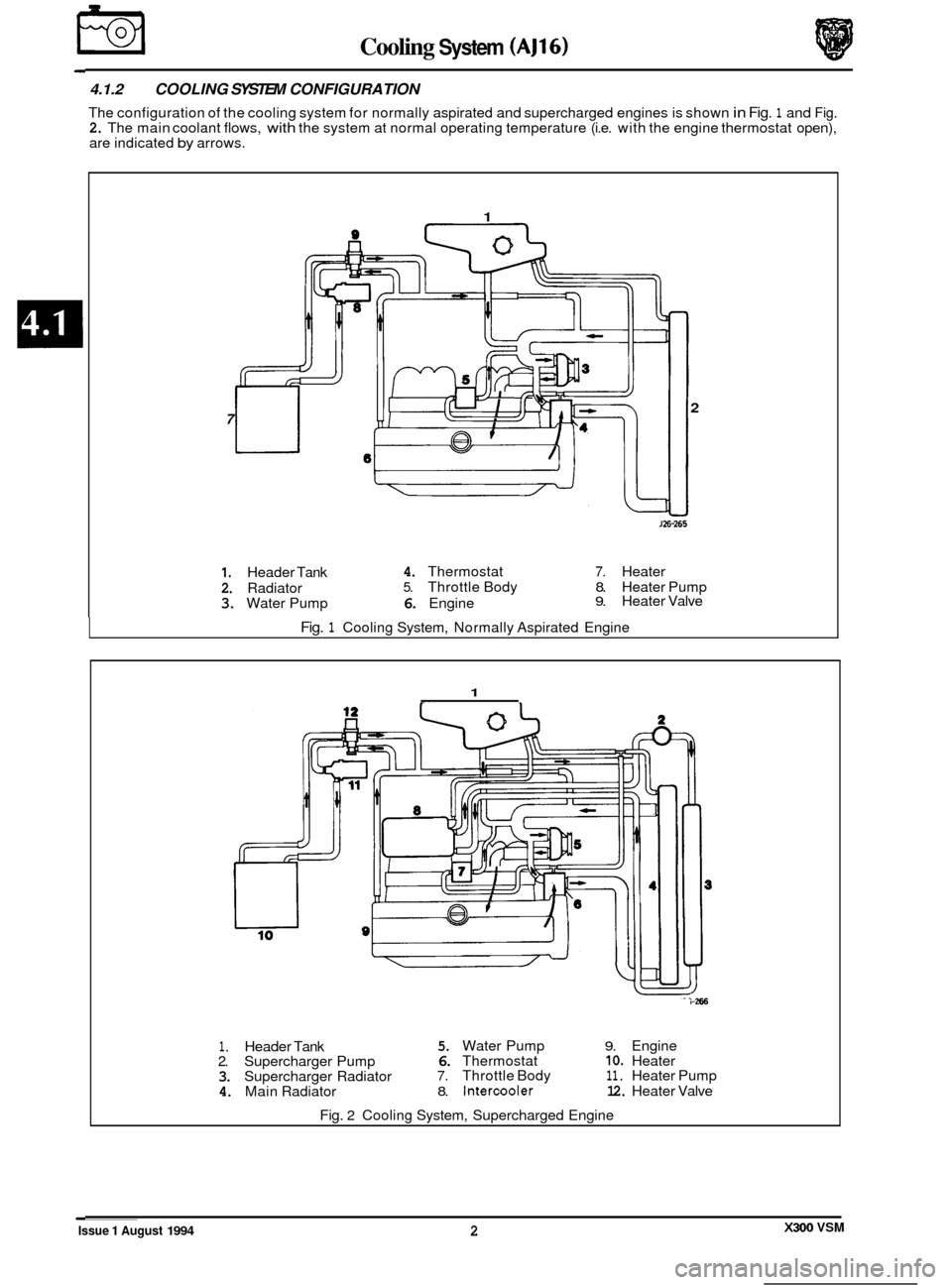
€3 Cooling System (AJ16)
4.1.2 COOLING SYSTEM CONFIGURATION
The configuration of the cooling system for normally aspirated and supercharged engines is shown in Fig. 1 and Fig. 2. The main coolant flows, with the system at normal operating temperature (i.e. with the engine thermostat open),
are indicated by arrows.
1
2 7
J26-265
1. Header Tank 4. Thermostat 7. Heater
2. Radiator 5. Throttle Body 8. Heater Pump
3. Water Pump 6. Engine 9. Heater Valve
Fig. 1 Cooling System, Normally Aspirated Engine
1
i-266
1. Header Tank 5. Water Pump 9. Engine
2. Supercharger Pump 6. Thermostat IO. Heater
3. Supercharger Radiator 7. Throttle Body 11. Heater Pump
4. Main Radiator 8. Intercooler 12. Heater Valve
Fig.
2 Cooling System, Supercharged Engine
Issue 1 August 1994 X300 VSM 2
Page 58 of 521
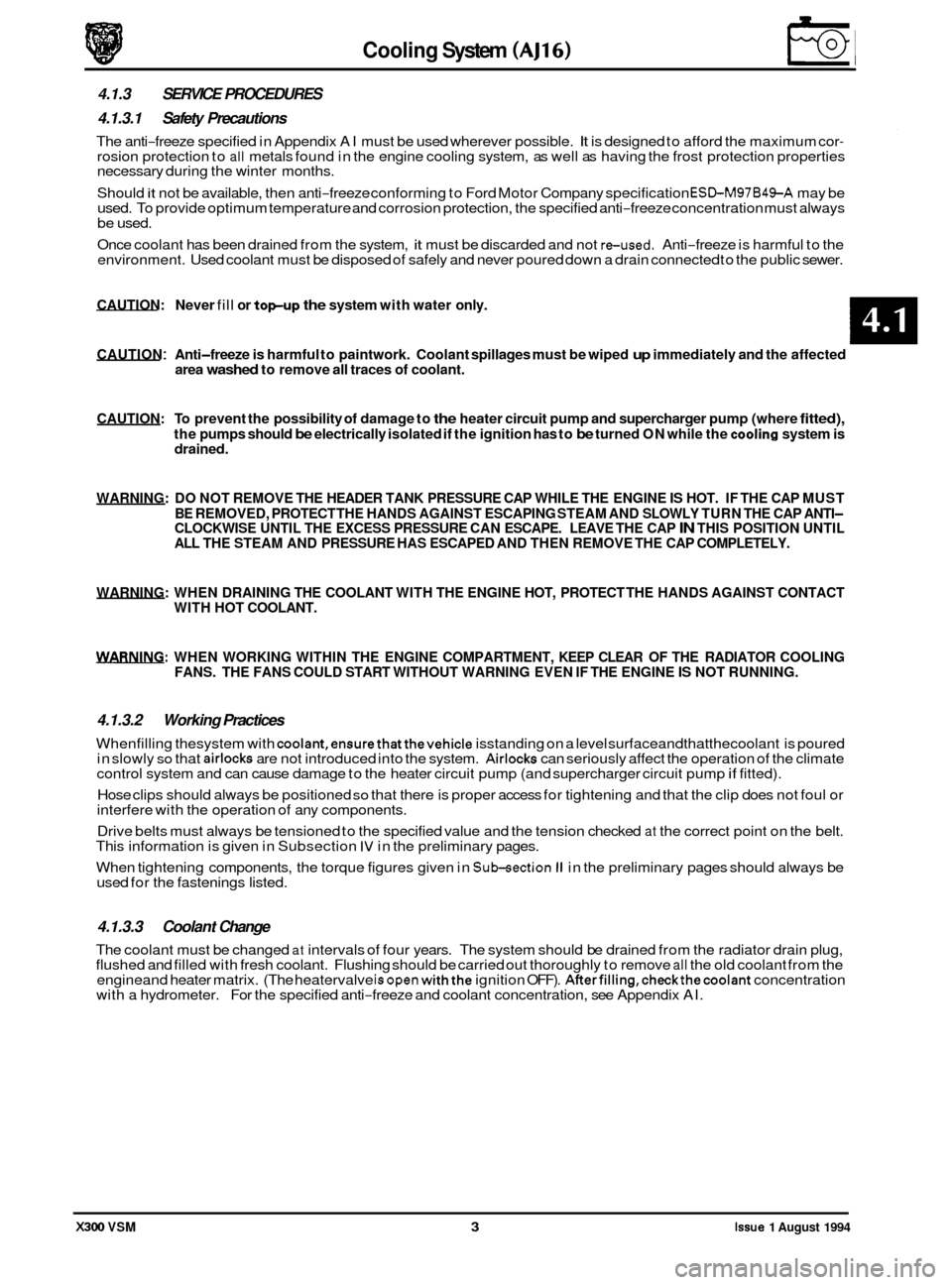
area washed to remove all traces of coolant.
CAUTION: To prevent the possibility of damage to the heater circuit pump and supercharger pump (where fitted),
the pumps should be electrically isolated if the ignition has to be turned ON while the cooling system is
drained.
WARNING: DO NOT REMOVE THE HEADER TANK PRESSURE CAP WHILE THE ENGINE IS HOT. IF THE CAP MUST
BE REMOVED, PROTECT THE HANDS AGAINST ESCAPING STEAM AND SLOWLY TURN THE CAP ANTI
- CLOCKWISE UNTIL THE EXCESS PRESSURE CAN ESCAPE. LEAVE THE CAP IN THIS POSITION UNTIL
ALL THE STEAM AND PRESSURE HAS ESCAPED AND THEN REMOVE THE CAP COMPLETELY.
WARNING: WHEN DRAINING THE COOLANT WITH THE ENGINE HOT, PROTECT THE HANDS AGAINST CONTACT
WITH HOT COOLANT.
WARNING: WHEN WORKING WITHIN THE ENGINE COMPARTMENT, KEEP CLEAR OF THE RADIATOR COOLING
FANS. THE FANS COULD START WITHOUT WARNING EVEN IF THE ENGINE IS NOT RUNNING.
4.1.3.2 Working Practices
Whenfilling thesystem with coolant,ensurethatthevehicle isstanding on a level surfaceandthatthecoolant is poured
in slowly so that airlocks are not introduced into the system. Airlocks can seriously affect the operation of the climate
control system and can cause damage to the heater circuit pump (and supercharger circuit pump if fitted).
Cooling System (AJ16)
4.1.3 SERVICE PROCEDURES
4.1.3.1 Safety Precautions
The anti-freeze specified in Appendix AI must be used wherever possible. It is designed to afford the maximum cor- rosion protection to all metals found in the engine cooling system, as well as having the frost protection properties
necessary during the winter months.
Should
it not be available, then anti-freeze conforming to Ford Motor Company specification ESLbM97B49-A may be
used. To provide optimum temperature and corrosion protection, the specified anti-freeze concentration must always
be used.
Once coolant has been drained from the system,
it must be discarded and not reused. Anti-freeze is harmful to the
environment. Used coolant must be disposed of safely and never poured down a drain connected to the public sewer.
CAUTION: Never fill or topup the system with water only.
CAUTION : Anti-freeze is harmful to paintwork. Coolant spillages must be wiped up immediately and the affected
Hose clips should always be positioned so that there is proper access for tightening and that the clip does not foul or
interfere with the operation of any components.
Drive belts must always be tensioned to the specified value and the tension checked
at the correct point on the belt.
This information is given in Subsection IV in the preliminary pages.
0
When tightening components, the torque figures given in Sukection II in the preliminary pages should always be
used for the fastenings listed.
4.1.3.3 Coolant Change
The coolant must be changed at intervals of four years. The system should be drained from the radiator drain plug,
flushed and filled with fresh coolant. Flushing should be carried out thoroughly to remove all the old coolant from the
engineand heater matrix. (The heatervalve isopen withthe ignition OFF). AfterfiIling,checkthecoolant concentration
with a hydrometer. For the specified anti-freeze and coolant concentration, see Appendix AI.
X300 VSM 3 Issue 1 August 1994
Page 59 of 521
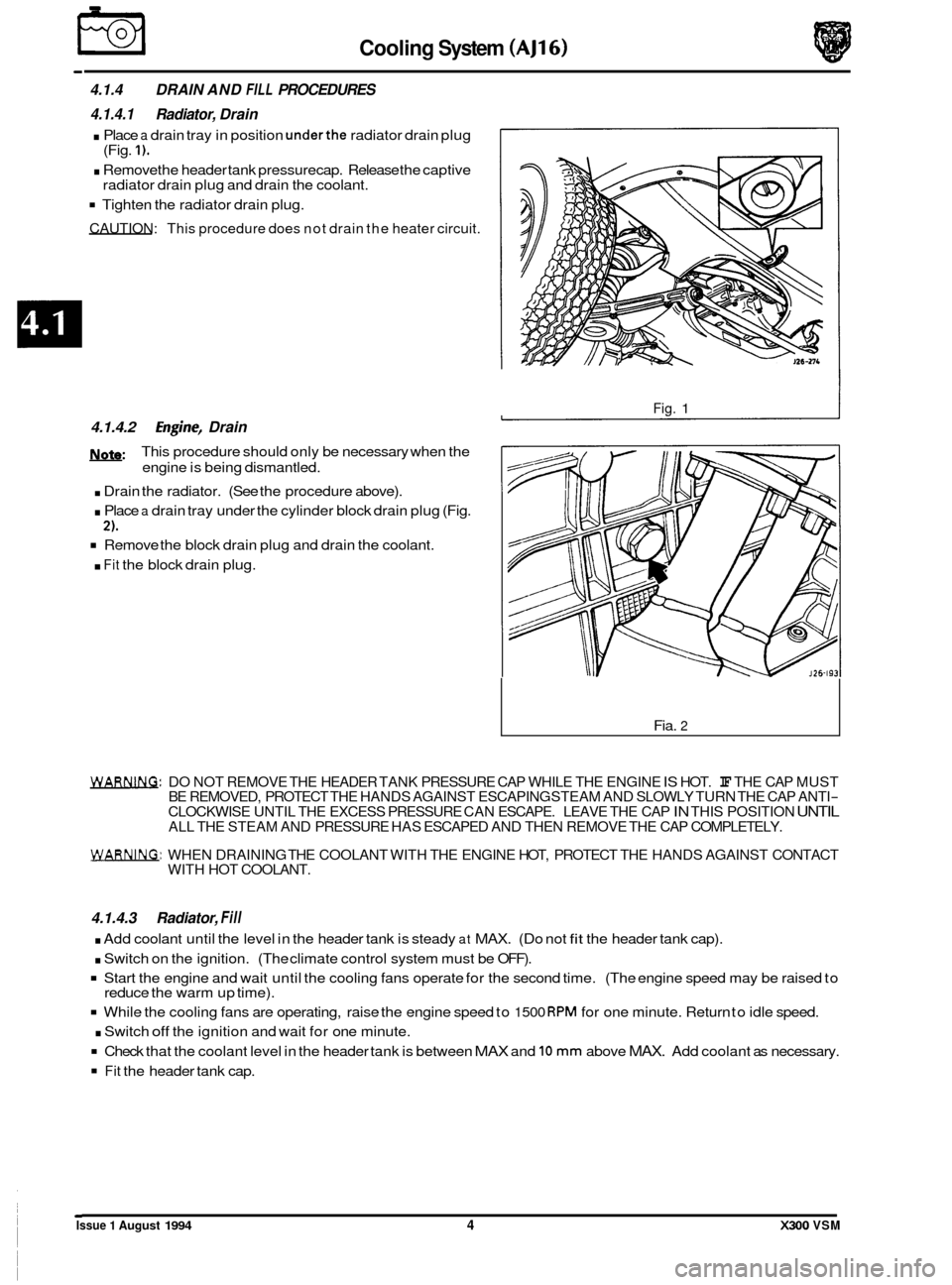
€3 Cooling System (AJ16)
4.1.4 DRAIN AND FILL PROCEDURES
4.1.4.1 Radiator, Drain
. Place a drain tray in position underthe radiator drain plug
. Remove the header tank pressure cap. Release the captive
Tighten the radiator drain plug.
CAUTION: This procedure does not drain the heater circuit.
(Fig. 1).
radiator drain plug and drain the coolant.
4.1.4.2 Engh-, Drain
m:
. Drain the radiator. (See the procedure above).
. Place a drain tray under the cylinder block drain plug (Fig.
Remove the block drain plug and drain the coolant.
. Fit the block drain plug.
This procedure
should only be necessary when the
engine is being dismantled.
2).
Fig. 1
Fia. 2
WAm. DO NOT REMOVE THE HEADER TANK PRESSURE CAP WHILE THE ENGINE IS HOT. IF THE CAP MUST
BE REMOVED, PROTECT THE HANDS AGAINST ESCAPING STEAM AND SLOWLY TURN THE CAP ANTI- CLOCKWISE UNTIL THE EXCESS PRESSURE CAN ESCAPE. LEAVE THE CAP IN THIS POSITION UNTIL ALL THE STEAM AND PRESSURE HAS ESCAPED AND THEN REMOVE THE CAP COMPLETELY.
WARNING: WHEN DRAINING THE COOLANT WITH THE ENGINE HOT, PROTECT THE HANDS AGAINST CONTACT
WITH HOT COOLANT.
4.1.4.3 Radiator, Fill
. Add coolant until the level in the header tank is steady at MAX. (Do not fit the header tank cap).
. Switch on the ignition. (The climate control system must be OFF).
Start the engine and wait until the cooling fans operate for the second time. (The engine speed may be raised to
While the cooling fans are operating, raise the engine speed to 1500 RPM for one minute. Return to idle speed.
. Switch off the ignition and wait for one minute.
Check that the coolant level in the header tank is between MAX and 10 mm above MAX. Add coolant as necessary.
Fit the header tank cap.
reduce
the warm up time).
Issue 1 August 1994 4 X300 VSM
Page 60 of 521
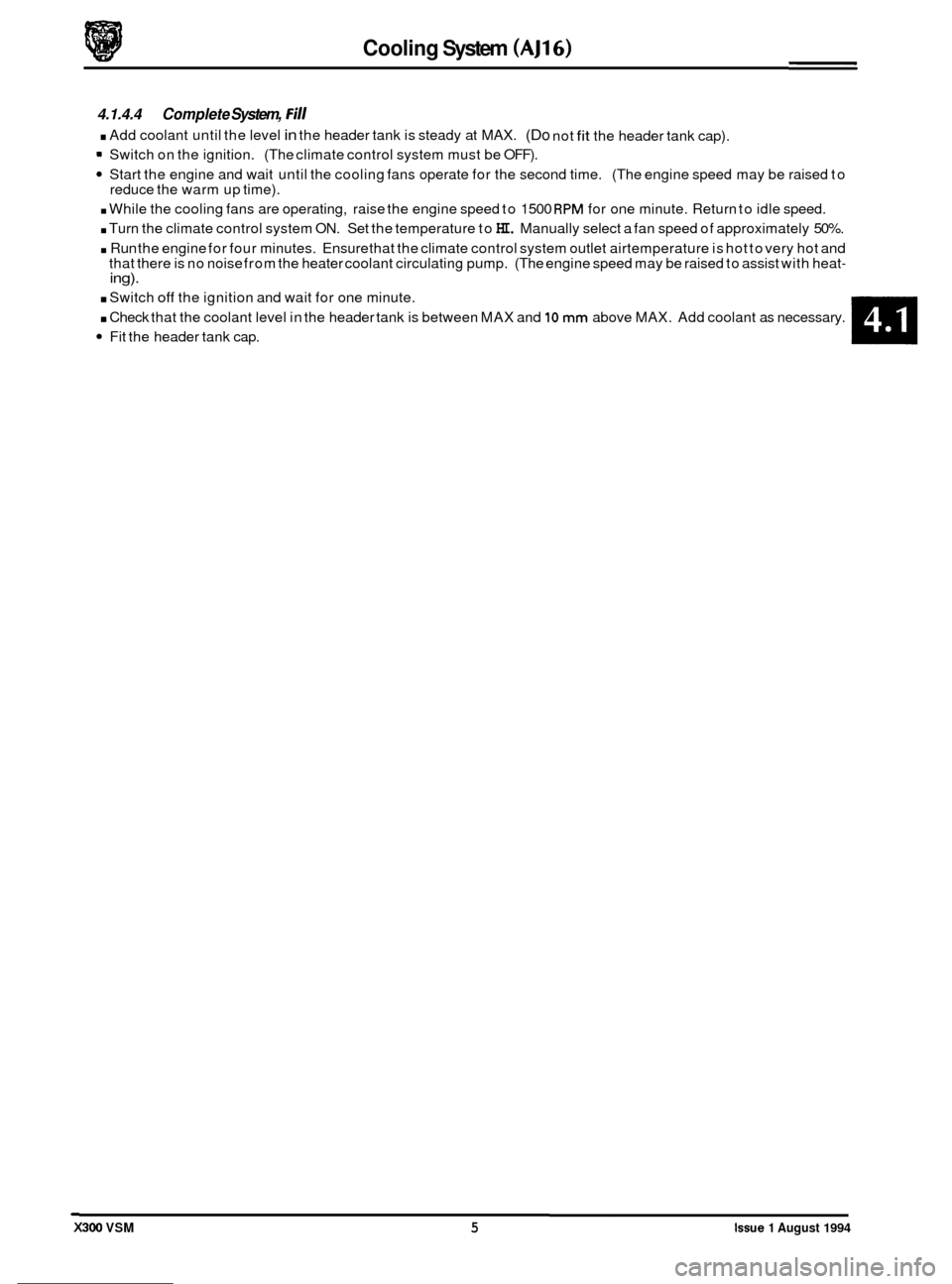
.
0
0
Cooling System (AJ1
4.1.4.4 Complete System, Fill
. Add coolant until the level in the header tank is steady at MAX. (Do not fit the header tank cap).
m Switch on the ignition. (The climate control system must be OFF).
Start the engine and wait until the cooling fans operate for the second time. (The engine speed may be raised to
. While the cooling fans are operating, raise the engine speed to 1500 RPM for one minute. Return to idle speed.
. Turn the climate control system ON. Set the temperature to HI. Manually select a fan speed of approximately 50%.
. Run the engine for four minutes. Ensure that the climate control system outlet airtemperature is hot to very hot and
that there is no noise from the heater coolant circulating pump. (The engine speed may be raised to assist with heat- ing).
reduce the warm up time).
. Switch off the ignition and wait for one minute.
. Check that the coolant level in the header tank is between MAX and 10 mm above MAX. Add coolant as necessary.
Fit the header tank cap.
X300 VSM 5 Issue 1 August 1994
Page 66 of 521
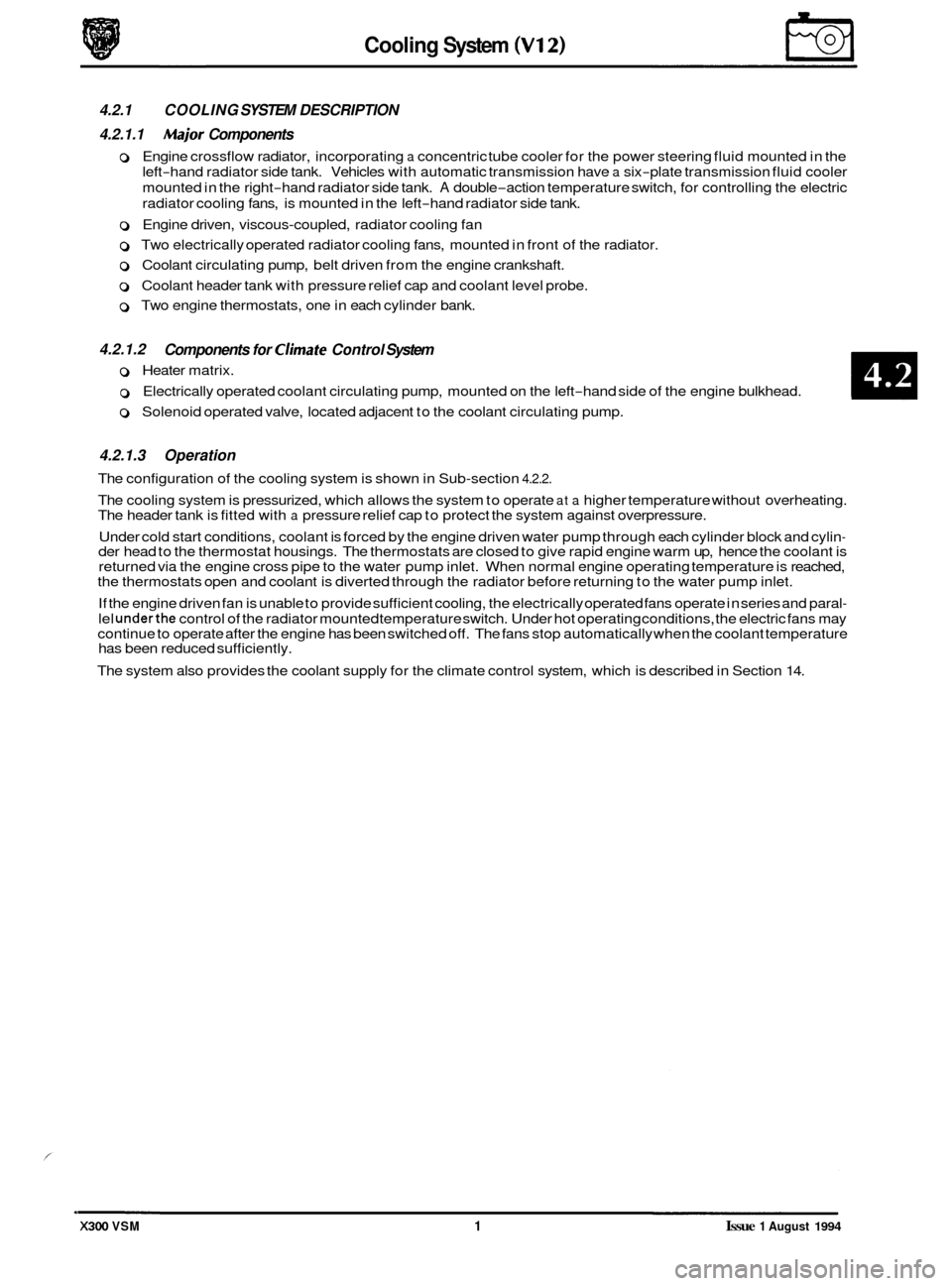
Cooling System (V12
4.2.1 COOLING SYSTEM DESCRIPTION I
4.2.1.1 Major Components
o Engine crossflow radiator, incorporating a concentric tube cooler for the power steering fluid mounted in the
left
-hand radiator side tank. Vehicles with automatic transmission have a six-plate transmission fluid cooler
mounted in the right
-hand radiator side tank. A double-action temperature switch, for controlling the electric
radiator cooling fans, is mounted in the left
-hand radiator side tank.
0 Engine driven, viscous-coupled, radiator cooling fan
0 Two electrically operated radiator cooling fans, mounted in front of the radiator.
o Coolant circulating pump, belt driven from the engine crankshaft.
0 Coolant header tank with pressure relief cap and coolant level probe.
0 Two engine thermostats, one in each cylinder bank.
4.2.1.2
0 Heater matrix.
0 Electrically operated coolant circulating pump, mounted on the left-hand side of the engine bulkhead.
o Solenoid operated valve, located adjacent to the coolant circulating pump.
Components for Climate Control System
1
4.2.1.3 Operation
The configuration of the cooling system is shown in Sub-section 4.2.2.
The cooling system is pressurized, which allows the system to operate at a higher temperature without overheating.
The header tank is fitted with a pressure relief cap to protect the system against overpressure.
Under cold start conditions, coolant is forced by the engine driven water pump through each cylinder block and cylin
- der head to the thermostat housings. The thermostats are closed to give rapid engine warm up, hence the coolant is
returned via the engine cross pipe to the water pump inlet. When normal engine operating temperature is reached,
the thermostats open and coolant is diverted through the radiator before returning to the water pump inlet.
If the engine driven fan is unable to provide sufficient cooling, the electrically operated fans operate in series and paral
-
lel underthe control of the radiator mounted temperature switch. Under hot operating conditions, the electric fans may
continue to operate after the engine has been switched off. The fans stop automatically when the coolant temperature
has been reduced sufficiently.
The system also provides the coolant supply for the climate control system, which is described in Section 14.
I
I X300 VSM 1 Issue 1 August 1994
Page 67 of 521
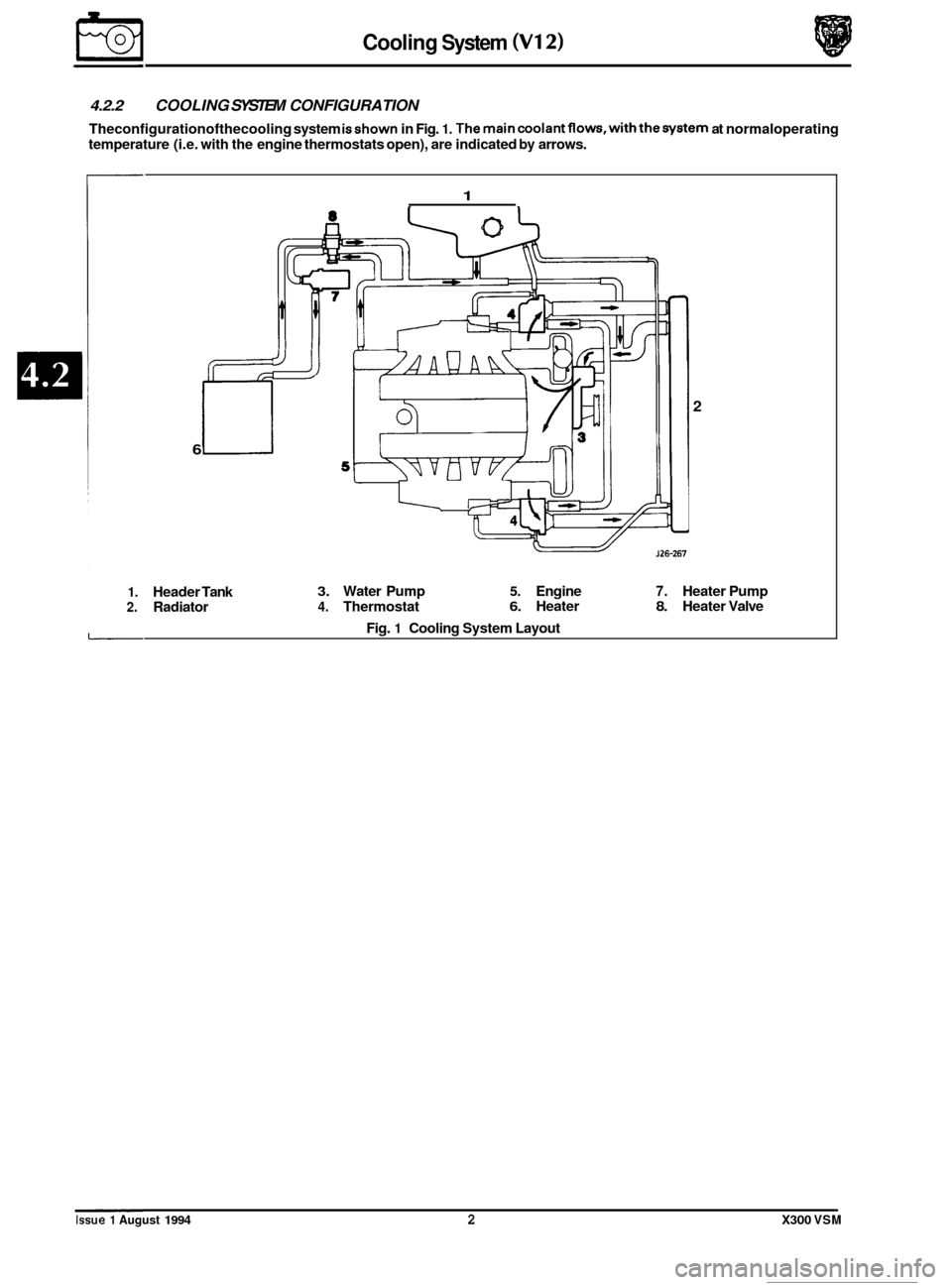
Cooling System (VI 2)
0
4.2.2 COOLING SYSTEM CONFIGURATION
Theconfigurationofthecooling system isshown in Fig. 1. Themaincoolantflows,withthesystem at normaloperating
temperature (i.e. with the engine thermostats open), are indicated
by arrows.
6 rr
1
2
1. Header Tank 3. Water Pump 5. Engine 7. Heater Pump
2. Radiator 4. Thermostat 6. Heater 8. Heater Valve
Fig.
1 Cooling System Layout
Issue 1 August 1994 2 X300 VSM